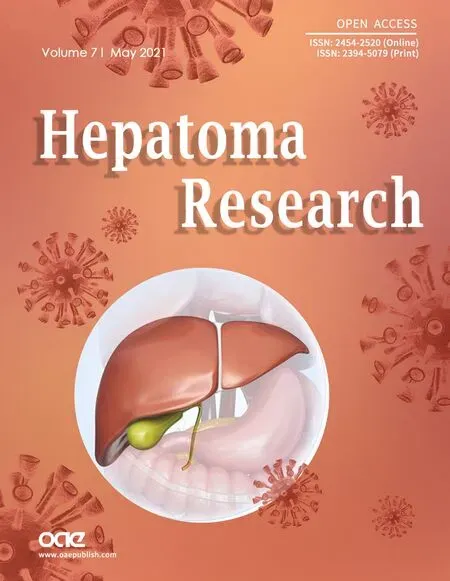The prognostic evaluation of marginal positive resection in hepatoblastoma: Japanese experience
Eiso Hiyama, Tomoro Hishiki, Kenichiro Watanabe, Kohmei Ida, Michihiro Yano, Sho Kurihara,Masato Kojima, Isamu Saeki, Takeshi Inoue, Yukichi Tanaka
1Department of Pediatric Surgery, Hiroshima University Hospital, Hiroshima 734-8551, Japan.
2Natural Science Center for Basic Research and Development, Hiroshima University, Hiroshima 734-8551, Japan.
3Department of Pediatric Surgery, Chiba University, Graduate School of Medicine, Chiba 260-8677, Japan.
4Department of Hematology and Oncology Shizuoka Children’s Hospital, Shizuoka 420-8660, Japan.
5Department of Pediatrics, Teikyo University Hospital Mizonokuchi, Kawasaki 213-8507, Japan.
6Department of Pediatrics, Akita University Hospital, Akita 010-8543, Japan.
7Department of Pathology, Osaka City General Hospital, Osaka 534-0021, Japan.
8Clinical Research Institute and Department of Pathology, Kanagawa Children’ Medical Center, Yokohama 232-8555, Japan.
Abstract Aim: In the Japanese study group for Pediatric Liver Tumor (JPLT) studies, the survival of patients with hepatoblastoma (HB) was improved by cisplatin/pirarubicin-based chemotherapy with combined surgical resection. We aimed to clarify whether marginal positive resection is correlated with the prognosis of HB patients from the JPLT-2 study (1999-2012).Methods: Of the 361 JPLT-2 patients, we excluded 4 who died before surgery, 14 inoperable following preoperative chemotherapy, and 6 macroscopically positive resections and analyzed local recurrence and survival rates in 337 patients who underwent primary resection including liver transplantation.Results: The five-year event-free survival (EFS) and overall survival (OS) rates were 76.0% and 87.7% in patients(n = 312) with complete resection of their primary tumors and 59.1% and 83.0% in those (n = 25) with microscopically margin-positive resection (microMPR), respectively. Among patients without distant metastasis,the five-year EFS and OS rates were 81.4% and 90.8% in those (n = 263) with complete resection vs. 62.5% and 90.9% in those (n = 22) with microMPR, respectively. The EFS, but not OS, was significantly lower (P < 0.05) in patients with microMPR vs. complete resection. The local recurrence rate was significantly different (chi-square =12.11, P < 0.01) between the two groups.Conclusion: In patients administered cisplatin/pirarubicin-based chemotherapy, the presence of microMPR influenced local recurrence but not outcome. Advance of liver surgery including LT correlated with improving of resection rates. The presence of microMPR influenced the local recurrence but not the outcome in the JPLT-2 study. The outcome of patients with microMPR might depend on the postoperative treatment and/or tumor biology rather than occurrence of recurrence.
Keywords: Hepatoblastoma, surgical margin, outcome, surgery, chemotherapy, microscopic positive
INTRODUCTION
Hepatoblastoma (HB), the most common childhood liver tumors, is usually detected in the children under 5 years old. The incidence of this tumor is 3-5 per 100,000 children less than 15 years of age[1]. In multicentric clinical trials of pre- and postoperative chemotherapy (CTx) with surgery including liver transplantation(LT), the five-year overall survival (OS) rate of HB patients has improved from 60% to 80%[2-6]. However, the survival outcomes of patients with advanced HB remain poor[3]. A favorable outcome requires total removal/shrinkage of the primary and metastatic tumors by surgery and the appropriate CTx. Patients whose lung metastasis has been cleared by SIOPEL4 high-dose cisplatin regimen showed favorable outcome[7]. Therefore, the poor survival outcome of HB might be associated with residual or unresectable tumors[3,8]. Therefore, to ensure satisfactory resection, liver transplantation may be considered post-CTx for patients with POST-Treatment EXTent of disease (POST-TEXT) IV or III tumors with positive annotation factors such as multifocality, encasement, or obliteration of the main and/or both left and right branch of portal veins and/or all three major hepatic veins, especially with tumors that are less responsible to CTx which, might reflect unfavorable tumor biology[9-12]. Primary LT is an effective treatment for patients with unresectable HB, with long-term survival rates of 78%-90%[12,13]. Recently, the advanced cases whose lung disease has responded completely to chemotherapy or has been cleared by surgery are also eligible for LT,and their survival is also satisfactory[14,15]. However, patients with residual metastases or other contraindications, as well as those whose family decides against the procedure, are ineligible for LT and instead undergo extended liver resection. In previous studies, extensive liver resection has been effective for treating patients with advanced HB, but the correlation between microscopically margin-positive resection(microMPR) and survival remains unclear[16-18].
In Japan, the survival of patients with HB has improved due to the results of the JPLT-1 and JPLT-2 clinical trials, which were conducted by the Japanese pediatric liver tumor study group and evaluated the use of cisplatin/pirarubicin-based CTx combined with surgical resection for HB[12,13]. In this study, the primary aim was to compare the outcomes of HB patients from the JPLT-2 trial who underwent microMPR with those who received microscopically margin-negative resection (microMNR).
METHODS
Patients
We aimed to clarify whether microMNR was correlated with the prognosis of HB patients from JPLT-2(1999-2012) for evaluating first line CTx (CITA: cisplatin/pirarubicin-based regimen) and second line CTx(ITEC: ifosfamide, pirarubicin, etoposide, and carboplatin regimen) combined with surgical resection for histologically diagnosed HB in children under 14 years old[3,19]. Of the 361 HB patients, 4 died before surgery, 14 were inoperative following preoperative CTx, and 6 underwent macroscopically positive resection and were excluded. Then, we analyzed the local recurrence and survival rates of the remaining 337 patients who underwent hepatic tumor resection including total hepatectomy with living-donor LT. In these cases, 14 PRETEXT I and 16 PRETEXT II cases underwent initial resection at diagnosis and 10 additional cases (4 PRETEXT I and 6 PRETEXT II) with tumor rupture also underwent initial resection at diagnosis for control of intra-abdominal hemorrhage.
Ethics approval was obtained from the ethics committee of each institution (Hiro-I-RIN-118). Written informed consent was obtained from the patients and/or parents before treatment.
Staging and treatments
A physical examination with medical history was carefully taken and routine imaging studies including chest radiography, abdominal ultrasound, contrast-enhanced computed tomography (CT), and magnetic resonance imaging (MRI) were performed according to the guideline of the JPLT-2 protocol. Blood samples were collected for liver function tests and alpha-fetoprotein (AFP) measurement according to the JPLT- 2 protocol.
Clinical staging was performed institutionally according to PRETEXT criteria as defined by SIOPEL[20,21].PRETEXT annotation factors were defined according to the 2005 revised PRETEXT criteria[22]. In this study,23 tumors were classified as PRETEXT I, 120 as PRETEXT II, 134 as PRETEXT III, and 84 as PRETEXT IV.We reclassified tumor histology according to an international pediatric liver consensus classification system[23].
The JPLT-2 protocol was designed to confirm the effectiveness of pre- and postoperative CTx. In JPLT-2,preoperative CTx using the cisplatin-pirarubicin (tetrahydropyranyl-adriamycin) regimen (CITA) and the second-line regimen of ifosfamide, pirarubicin, etoposide, and carboplatin (ITEC) were administered according to the PRETEXT-based risk stratification system [Figure 1][3,19]. For patients with unresectable or metastatic disease, we evaluated the efficacy of high-dose CTx with stem cell transplantation[3,24-26]. Briefly,PRETEXT I tumors and some PRETEXT II tumors without PRETEXT annotation factors were resected at diagnosis (up-front resection) (Stratum 1). Ruptured PRETEXT I or II tumors also underwent up-front resection to control hemorrhaging. PRETEXT II tumors without annotation factors, except for tumor multifocality, received two cycles of preoperative CTx with half-dose CITA (Stratum 2). All PRETEXT III or IV and PRETEXT I/II tumors with annotation factors, including preoperative rupture without initial resection, macrovascular invasion, and metastatic disease, received two cycles of preoperative CITA.Patients who were deemed responders, according to the RECIST criteria and a decreased AFP level,underwent two more cycles of CITA followed by resection (Stratum 3). For non-responders, two cycles of the ITEC regimen were added (Stratum 4). CITA or ITEC was repeated for six cycles if surgical treatment was considered difficult after four cycles. All patients in the whole cohort received postoperative CTx.Patients in Stratum 1 or 2 were treated with two cycles of low-dose CITA, and those in Stratum 3 or 4 were treated with two cycles of CITA or ITEC, respectively. If no complete response of the metastatic lesions was achieved at this point, two additional cycles were added. Patients with persistent metastatic disease or refractory PRETEXT IV disease were eligible to receive high-dose CTx with stem cell transplantation after tumor resection (including metastasectomy) according to the institutional decision.
Determination of a positive margin
The histopathologic classification of the specimens at diagnosis was performed via central review by three pathologists [Figure 2]. The diagnosis of microMPR and microMNR (complete resection) was based on local pathology reports; the diagnosis of some cases was determined by central review.
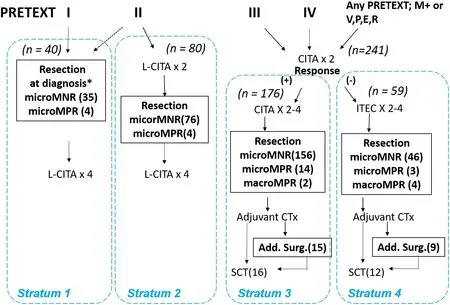
Figure 1. Treatment flow of patients through the Japanese Study Group for Pediatric Liver Tumors-2 study. *Six were macroscopically marginal positive resection. MNR: Microscopically marginal negative resection; microMPR: microscopically marginal positive resection;CITA: cisplatin and pirarubicin; L-CITA: low-dose CITA; ITEC: ifosfamide, pirarubicin, etoposide, and carboplatin; Add. Surg.: additional surgery; CTx: chemotherapy; SCT: high-dose chemotherapy with stem cell transplantation.
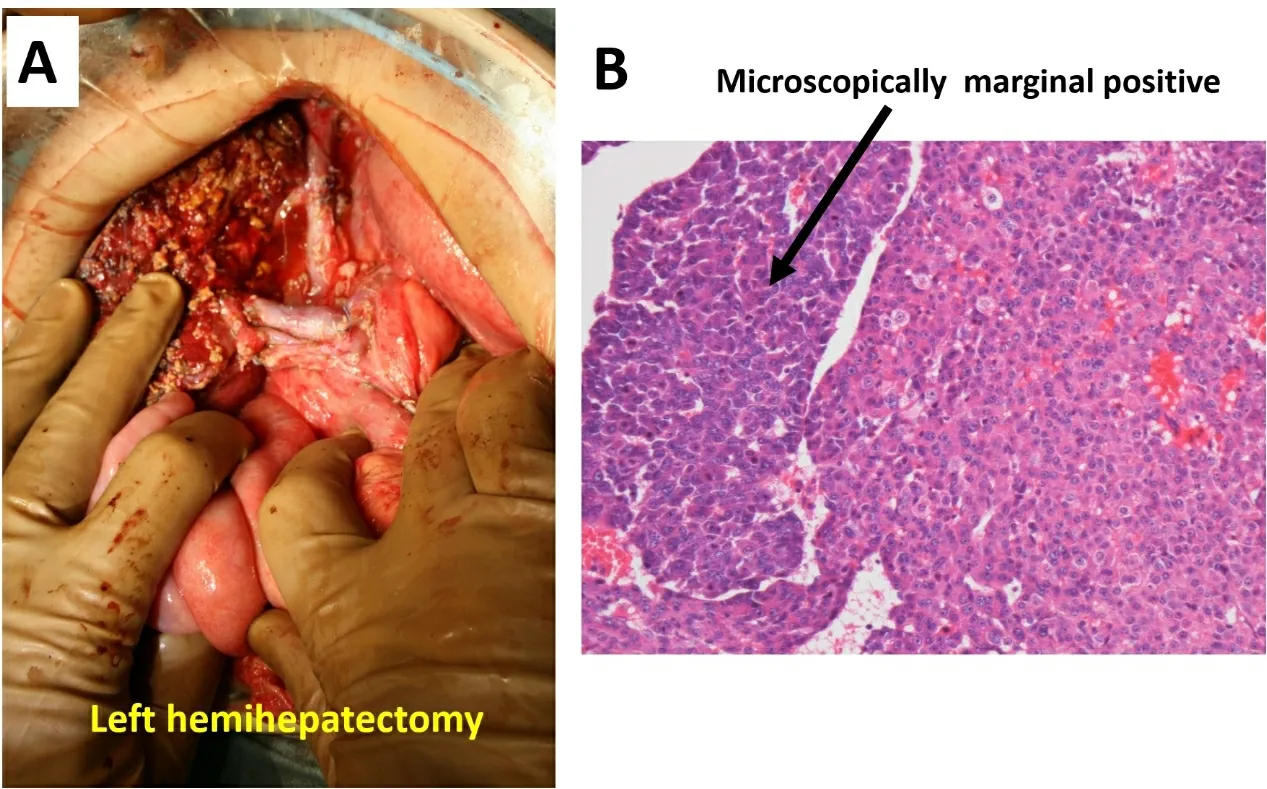
Figure 2. A representative case of a microscopically positive resection margin: (A) this tumor was PRETEXT III and underwent left hemihepatectomy after four cycles of the CITA regimen; and (B) histological examination revealed residual tumor cells at the margin of the resected specimen.
Follow up
Follow-up evaluation comprised measurement of the postoperative serum AFP level and abdominal ultrasonography and/or CT in all patients, performed at least once every six months. Complete remission was defined as no evidence of disease on imaging and a normal AFP level. Event-free survival (EFS) and OS were the endpoints of this study. EFS was defined between the date of registration and the earliest date of the first occurrence of progression or relapse, death, or the latest contact. OS was defined the time between the date of registration and the date of death or the last contact.
Statistical analysis
Student t-test or Chi-square test was used to compare characteristics or values between groups, as appropriate. Survival curves were analyzed by the Kaplan-Meier method for evaluation of the five-year OS and EFS rates and the log-rank test was used to compare these curves. Cox’s regression method was used for the multifactor analysis. Statistical significance was defined as P < 0.05.
RESULTS
Of the 361 HB patients from JPLT-2, 4 died before surgery and 14 had unresectable tumors following preoperative CTx. In the remaining 343 patients (95.0%), primary tumor resection including total hepatectomy followed by LT (n = 17) was performed. Among them, there were 6 cases of macroscopically incomplete resection (1.7%). Histological examination of the resected margin of resected tumor specimens in the remaining cases revealed that 25 cases (6.9%) were marginal positive [Table 1 and Figure 2].
Consequently, complete resection was achieved in 312 (86.4%), which was a significantly higher resection rate than that in the previous JPLT-1 trial (71.6%) [Figure 3]. The resection rate was 90.4% (n = 263) in the patients with non-metastatic disease (n = 291) and 73.8% (n = 62) in those with PRETEXT IV tumors(n = 84); these rates were also significantly higher than those in JPLT-1 (81.3% and 40.0%, respectively).
The five-year EFS and OS rates were 76.0% and 87.7% in the patients who underwent complete resection(microMNR) of their primary tumor (n = 312), respectively, compared with 60.3% and 83.1% in those who underwent incomplete resection (n = 31), including microMPR (n = 25) [Table 1 and Figure 4]. Among the patients without distant metastasis (n = 290), the five-year EFS and OS rates were 81.8% and 90.8% in those with complete resection (n = 263), respectively, compared with 68.2% and 90.9% in those with microMPR (n= 22). The EFS rates were significantly higher (P = 0.031 and P = 0.022, respectively) in the patients with complete resection vs. microMPR. Events occurred in 72 and 11 cases in patients with complete resection and microMPR, respectively, and a significantly higher rate of intrahepatic local recurrence was found in the latter cases [32 (10.2%) vs. 9 (36.0%), chi-square = 12.11, P < 0.01], whereas the OS rate did not differ significantly (P = 0.135) between the two groups. In the patients who underwent complete resection(microMNR) of their primary tumor without LT, the five-year EFS and OS rates were 76.3% and 88.2% in total (n =295) and 81.9% and 92.0% in those without distant metastasis, respectively. The EFS rate was also significantly higher (P = 0.027 and P = 0.015, respectively) in the patients with complete resection vs.microMPR. Except for the cases with macroscopic positive margin, regression analysis using a multivariable Cox proportional hazards model revealed that age of more than 8 years, distant metastasis, and microMPR were independent predictors of shorter EFS, but PRETEXT classification including co-factors except for metastasis was not significantly correlated with EFS [Table 2]. An extended hepatectomy was performed in 122 (39.0%) of 337 cases who underwent resection of primary tumor. MicroMPR cases included 15 of 122 cases with extended hepatectomy and 10 of the remaining cases. A significantly higher rate of microMPR occurred in extended hepatectomy cases [15 (12.3%) vs. 10 (4.7%), chi-square = 6.60, P = 0.012].
Among 11 patients with a tumor with microMPR who had recurrence, 7 patients had a tumor with local recurrence, 2 had lung metastasis, and 2 had both. Among them, 2 cases underwent surgical approaches consisting of LT (n = 1) and lung metastasectomy (n = 1), but they both died of disease. Six were alive after pirarubicin); LC: low CITA regimen; I: ITEC regimen (ifosfamide, pirarubicin, etoposide, and carboplatin); local: local recurrence in liver; lung: lung metastasis; CTx: chemotherapy; LT: liver transplantation; CPT-11:irinotecan; metastasec, lung metastasectomy; m: months after diagnosis.additional CTx (n = 4), CTx plus radiation therapy (n = 1), and high-dose CTx with stem cell transplantation (n = 1). Among them, one case died of secondary malignancy at 7 years 10 months after diagnosis regardless the remission of recurrence (Case 6 in Table 1).

Table 1. Cases with microscopically positive margin at surgery
Forty patients received up-front resection (Stratum 1 in Figure 1). Ten with ruptured tumors underwent emergent resection to achieve hemostasis. The remaining 30 patients included 14 with PRETEXT I tumors without annotation factors and 16 with PRETEXT II tumors who underwent Stratum 1 treatment by institutional decision. Of these 30 patients, all achieved microMNR except for one (aged one month) who underwent partial resection for a tumor involving Segments 5-8 with microMPR (Case 9 in Table 1). This patient achieved five-year EFS, but another patient (aged 16 months) who underwent right hepatectomy for a large tumor involving Segments 5-8 with right hepatic vein invasion died from surgical complications regardless of microMNR.
DISCUSSION
HB is usually diagnosed as a large abdominal tumor involving 3 or 4 segments of the liver and compressing the portal and/or hepatic vein. Even if the tumor is PRETEXT I or II, it usually involves the middle hepatic vein such that surgical resection with a sufficient margin is difficult in most cases. Although LT has become a safe and effective treatment for children with advanced HB, it is sometimes delayed for several reasons, such as residual metastatic lesions, the difficulty of donor selection for living donor LT, and issues with post-surgical administration of immunosuppressive drugs. Therefore, surgeons may choose extensive liver resection to treat children with advanced HB who might be indication of LT. However, in patients with large tumors undergoing aggressive hepatic resection, attention must be paid to the remaining liver volume and to preservation of the vital vessels attached to or encased by the tumor. In such cases, even if the tumor is removed macroscopically by cautious resection, microscopic residual tumor is sometimes detected at the margin of the resected liver by histologic examination, consequently resulting in microMPR. In fact, in the present study, the extended right or left hepatectomy had a significantly high rate of microMPR. In these cases, attention must be paid to avoid microMPR due to large existing tumor and the viable cells remaining by less chemoresponsiveness.
The correlation between microMPR and the survival rates of children with HB remains controversial[16,18]. The analysis of SIOPEL studies presented similar outcomes between children with microMPR and those with microMNR, especially in those whose tumors showed effective responses to preoperative CTx[16,27].In a retrospective study of patients from a single Asian institution, the five-year OS and EFS rates were lower in the microMPR cases compared to JPLT-2 and SIOPEL studies[18]. In that report, there was no significant difference in the rate of hepatic recurrence between the two groups of complete and microMPR resection cases, even after adjustment for the response to neoadjuvant CTx. Their explanation for this result is that the outcome might depend on HB chemosensitivity. Neoadjuvant and adjuvant CTx can shrink the size of the tumor and diminish small pulmonary metastases, but it might also control the microscopic residual tumor at the margin. Another possibility could be the use of energy-based surgical instruments, such as high-frequency electrotomes and ultrasonic knives, which may induce thermal damage to microscopic residual tumor cells at the margin of the preserved liver portion[28]. On the other hand, in the present study evaluating the prognostic impact of microscopic residual tumor cells, EFS was significantly worse in the patients with microMPR compared to those with microMNR (complete resection). EFS was also significantly worse in the patients without metastasis. These patients were treated with the same neoadjuvant therapy according to the risk stratified groups in JPLT-2. The events that occurred were mainly local recurrence and then lung metastasis,suggesting that microscopic residual tumor cells might be directly correlated to complications such as local recurrence. On the other hand, OS showed no significant difference between these microMPR and microMNR groups, suggesting that the survival of the patients with events such as local recurrence did not worsen due to aggressive CTx and additional surgery to treat the recurrence. In our cohort, 11 patients of microMPR group were treated by additional surgery, chemotherapy, and radiation therapy. Consequently, 5 of them survived. Additional surgery did not seem to contribute to outcome. The malignant grades or biological feature of recurrent tumors might be correlated to their outcomes. Consequently, the additional chemotherapy led to the increase of total dosage of chemotherapeutic agents. As shown in our previous study, the rate of late complications increased significantly with the CTx drug dose[3]. Indeed, one of these relapse cases suffered from secondary cancer. Therefore, microscopically positive margins should be avoided in HB treatment.

Table 2. Multivariate Cox regression analysis including all variables for event-free survival of 337 hepatoblastoma patients who underwent tumor resection without macroscopically positive resection
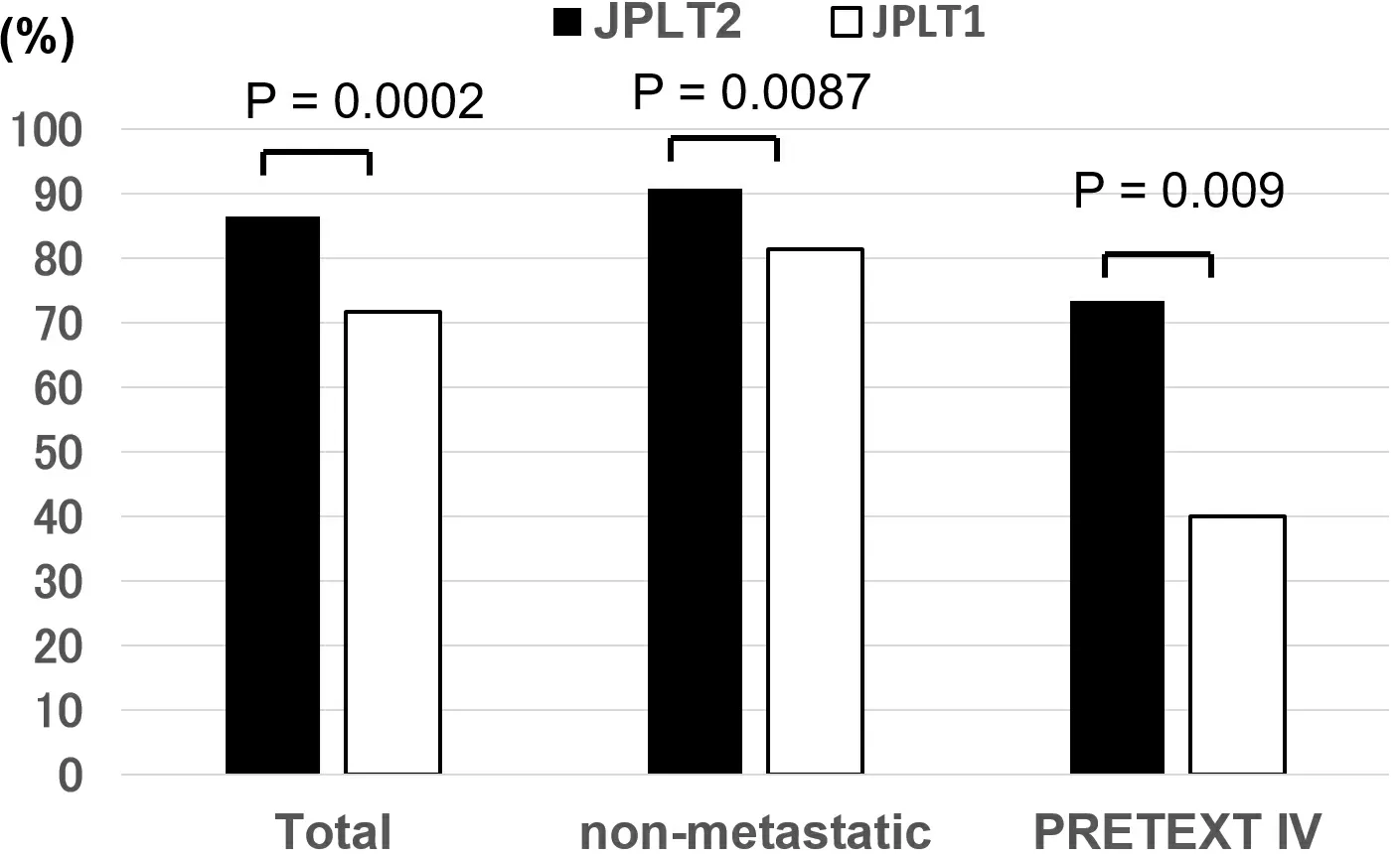
Figure 3. Resection rates of primary tumors in the JPLT-1 and JPLT-2 trials. The resection rate of primary tumors was 86.4% in JPLT-2 vs. 71.6% in JPLT-1 (chi-square = 13.743, P = 0.0002). The resection rate was significantly higher in JPLT-2 than JPLT-1. The resection rate of the patients without distant metastasis was 90.7% in JPLT-2, which was a significant improvement compared with the rate in JPLT-1 (81.4%). In particular, the resectability of non-metastatic PRETEXT IV tumors was significantly improved in JPLT-2 compared with JPLT-1 (73.2% vs. 40.0%). JPLT: Japanese study group for Pediatric Liver Tumors.
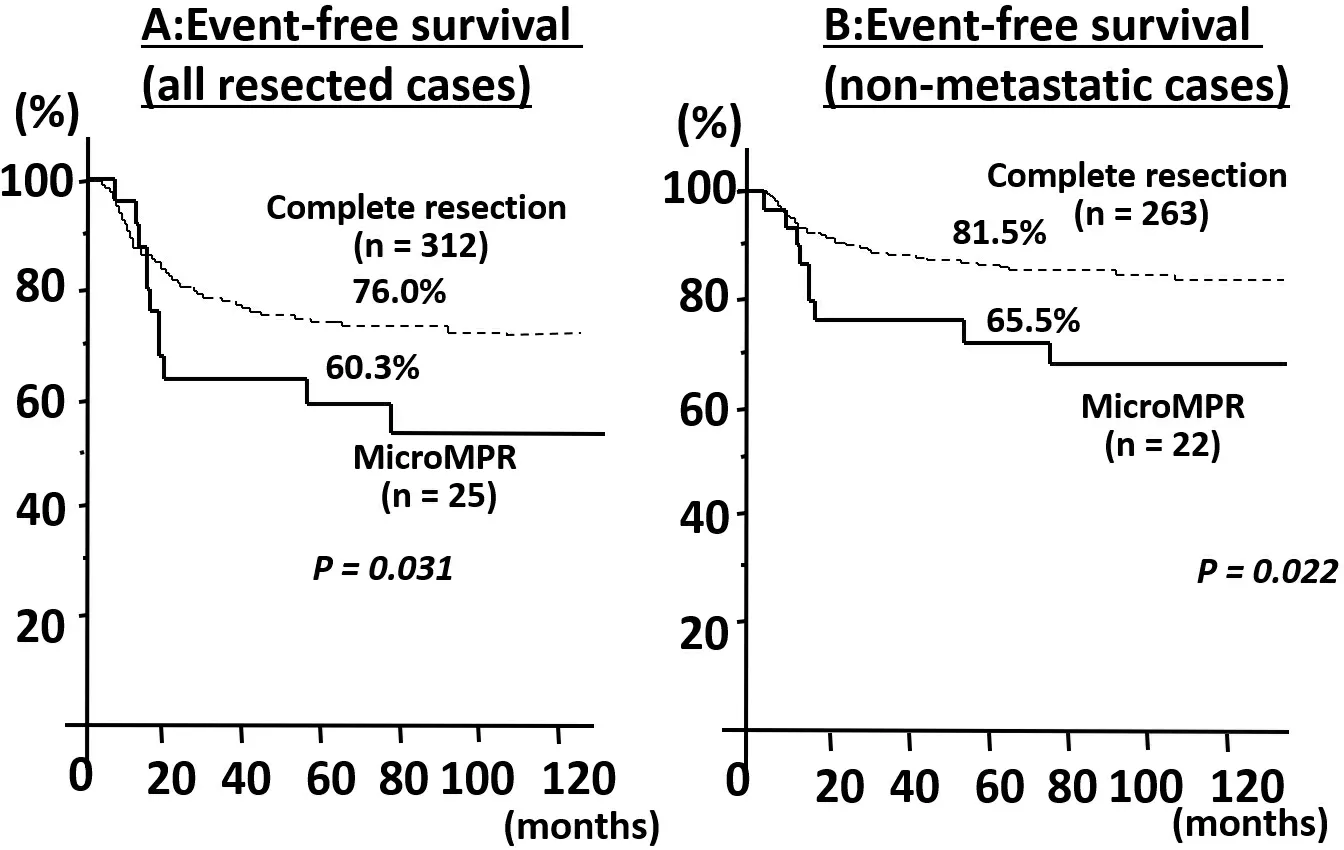
Figure 4. Event-free survival (EFS) rates of the cases with microscopically positive or negative (complete resection) margins: (A)among all resected cases; and (B) among non-metastatic cases that underwent primary tumor resection. Five-year EFS rates are shown in this figure. The cases with microscopically positive margins showed poorer outcomes compared to those with negative margins.MicroMPR: Microscopically marginal positive resection.
In a previous analysis of the same cohort[3], resectability was evaluated by imaging, and the patients were classified according to tumor response as responders (complete or partial response) or non-responders(stable disease or progressive disease) according to the RECIST criteria. Chemo-responders and tumor resectability after neoadjuvant CTx were correlated with favorable outcomes. In that analysis, the resectable cases included the microMPR cases. The tumor response was significantly correlated with resectability.Indeed, among the patients without metastasis, EFS was significantly longer in the chemo-responders, but OS showed no significant difference. This result might suggest that poor chemosensitivity is also correlated with residual tumor cells at the surgical margin.
We also compared the resection rate in our study with that in the previous JPLT-1 trial[29]. The resection rate was significantly higher in JPLT-2, especially in the non-metastatic or PRETEXT IV cases. The resection rates were 67% in SIOPEL-2 and 74% in SIOPEL-3[16], which were equivalent to those in JPLT-1. The recent developments in surgical treatment strategies, including extreme hepatic resection techniques and LT,which exhibit good safety and liver function preservation, may have contributed to the better resection rates in JPLT-2. In particular, the resectability rate for non-metastatic PRETEXT IV cases was significantly better in JPLT-2 than in JPLT-1 (73.2%vs. 40.0%) (chi-square = 6.814,P= 0.009). In contrast, the five-year EFS and OS rates were poor in both trials (40.2% and 57.9%vs. 40.6% and 38.9% in JPLT-2vs. JPLT-1). Of the current surgical options for HB, complete tumor resection remains the cornerstone of therapy, as it offers the only realistic chance of long-term disease-free survival[30-32]. In our series, patients who underwent incomplete resection had a significantly higher rate of relapse, suggesting that complete resection(microMNR) is necessary for improved outcomes. Moreover, 13 cases of recurrence among 31 cases with positive margins underwent extended or massive hepatectomy, and 10 of them were diagnosed between 2000 and 2005, suggesting that LT might be indicated in these cases. In liver surgery, developments in imaging procedures such as CT and MRI provide three-dimensional images that can reveal vascular remodeling and the exact residual volume after liver resection. In addition, technical developments in surgical liver transection such as ultrasonic dissectors and clamp crushing with intraoperative ultrasound,use of vascular staplers, and low central venous pressure anesthesia have resulted in increased eligibility for liver resection. Consequently, the number of cases undergoing liver resection has increased, thereby increasing the rate of microMPR. Therefore, currently, we should reconsider the evaluation of microMPR in hepatic resection for HB. Complete resection with LT might decrease the total dose of adjuvant CTx needed and the requirement for additional surgery, resulting in a decreased rate of late complications[3].
Patients with advanced HB are usually candidates for primary LT and aggressive hepatic resection. The benefits and disadvantages of LT and hepatic resection should be discussed by the hepatic surgery team involving LT surgeons. The marginal positive resection should be discussed as one of the disadvantages of aggressive hepatic resection.
The present study has several limitations. First, as described in the previous paragraph, the JPLT-2 study was conducted over more than 10 years, during which the indication and outcome of LT for children had dominantly changed. The extensive resection in the early era when LT was difficult caused high incidence of marginal positive resection. Second, the biological characteristic of tumor cells was not evaluated in this study. There is a possibility that highly malignant HBs might form more invasive tumors, resulting in high incidence of marginal positive resection and increasing recurrence. To consider these possibilities,prospective studies on extensive hepatectomy and LT for advanced HB and biological analysis of recurrence or refractory HB including tumor with microMPR are needed in the future.
In conclusion, after effective CTx, microMPR was associated with worse EFS in children with HB undergoing surgical resection.
DECLARATIONS
Acknowledgments
The authors would like to thank all members of the liver tumor committee of the Japan Children’s Cancer Group for their contributions to this paper and the JPLT-2 study.
Authors’ contributions
Made substantial contributions to the conception and design of the study and performed the data analysis and interpretation: Hiyama E, Hishiki T, Watanabe K, Ida K, Yano M
Performed data acquisition, as well as provided administrative, technical, and material support: Kurihara S,Kojima M, Saeki I
Pathological data analysis: Inoue T, Tanaka Y
Availability of data and materials
The datasets are not available for public access due to patient privacy concern enrolled in JPLT-2 trial because of the risk that will come into conflict with Personal Information Protection Law in Japan.
Financial support and sponsorship
This work was supported by AMED (Academy for Medical Research and Development) (Nos.20lk0201066h0004 and 20ck0106609h0001).
Conflicts of interest
All authors declared that there are no conflicts of interest.
Ethical approval and consent to participate
This study was performed in accordance with the Declaration of Helsinki and approved by the ethics committee of Hiroshima University (Hiro-RIN-113). Informed consent to participate in the study was obtained from the participants, or their parents or legal guardians if under age 16 years.
Consent for publication
Written informed consent was obtained from the patient who underwent surgery.
Copyright
? The Author(s) 2021.
- Hepatoma Research的其它文章
- GENERAL INFORMATION
- AUTHOR INSTRUCTIONS
- Surgical perspective on treatment of pediatric undifferentiated sarcoma of the liver
- Role of CD4+ T-cells in the pathology of non-alcoholic fatty liver disease and related diseases
- Defining the role of laparoscopic liver resection in elderly HCC patients: a propensity score matched analysis
- Contribution of C3G and other GEFs to liver cancer development and progression

